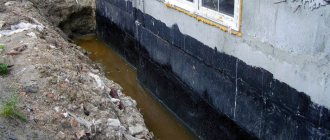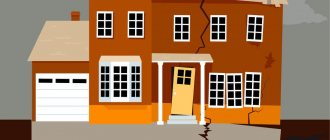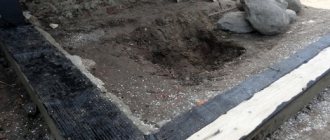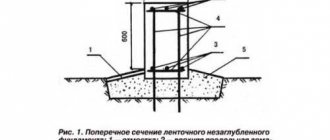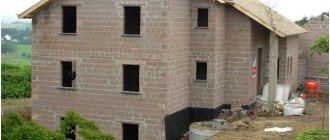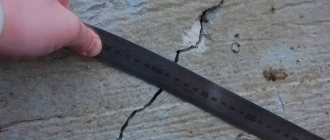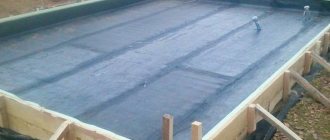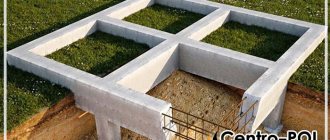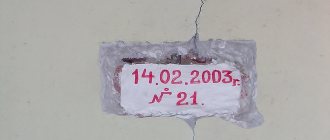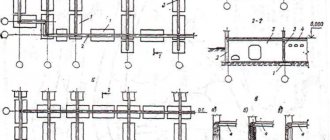0
3219
30.10.2013
Laminated foundation waterproofing is used to protect against pressure groundwater with a hydrostatic force of more than 0.1 MPa. It is distinguished from coating waterproofing by its greater mechanical strength and water resistance. Pasted waterproofing is carried out in the form of a continuous carpet, consisting of several layers of rolled material, connected to each other using mastics and adhesives and fixed to the base.
Pasted waterproofing of the foundation
Installation of roll materials can be carried out in several ways:
- Gluing using mastics and glue;
- By gluing on a self-adhesive layer;
- Fusing by heating a bitumen or polymer layer applied to roll waterproofing.
What it is?
Bonded foundation waterproofing is a waterproofing method in which insulating materials are glued to the surface of the foundation.
A protective layer of flexible sheet panels or roofing felt rolls is installed. First, the base is brought into proper condition: leveled, possible concreting defects are removed, and cleaned of dirt, dust, grease, debris and sand. An adhesive may be used.
Parts of the waterproofing are glued on manually, without using any additional means . Before applying insulation, you can treat the foundation with mastic.
Traditional cardboard in roofing felt in modern waterproofing is replaced with a reinforcing base - polymer or fiberglass.
Scope of application
Waterproofing is used to prevent the destruction of the foundation due to water ingress. Concrete absorbs water, which can rise higher and destroy both the base and the upper layers of the building, so the base is covered with waterproofing materials.
The pasting method is used on horizontal, vertical or inclined surfaces. This approach is used in almost any construction of structures, because repairing a building and eliminating cracks is much more expensive than waterproofing at the initial stages of construction.
Advantages and disadvantages
Tapered waterproofing is a good way to protect the foundation from moisture penetration. It has a sufficient number of advantages:
Low cost of materials. Prices vary depending on the composition and manufacturer, but are still an order of magnitude lower than prices for materials for other types of waterproofing.- Quick application of waterproofing coating.
- No need for special tools to perform the work.
It is worth saying that the second and third points are relative, because before starting work, certain preparation is required, which is one of the disadvantages of this method of protecting the foundation from moisture.
Here is a list of cons:
- The need for surface preparation. First you need to treat the foundation and eliminate all concrete defects, and also cover the surface with mastic.
- Pasting can be carried out only at positive temperatures: from +5 degrees and above.
- Low quality insulation when applied to wet surfaces.
- Impossibility of application on surfaces with complex configurations. Small diameter pipes and small protrusions will become an obstacle.
- Low maintainability.
How to apply the material
Roll waterproofing during installation requires compliance with certain rules. The process consists of the following stages:
1.The surface to be pasted is leveled, cleaned of dust, dirt, and dried.
2. The protrusions of the reinforcing elements are cut off so as not to tear the insulating material. All cracks and holes are covered with cement.
3.Next to the foundation you need to unroll a roll of material for leveling. If there is no place to unfold the roll, you need to rewind the material in the opposite direction.
4. To paste the material, you need to select a brand of bitumen. This is influenced by the air temperature. There are bitumen-polymer and rubber mastic.
5. The bitumen type of mastic must be heated to twenty-five degrees above the air temperature.
Attention! To heat the mastic, use a gas or gasoline burner with a metal container.
6. The thickness of the first layer should be two millimeters; work is carried out using a roller or brush.
7. Pieces of material overlap several centimeters. If possible, you need to glue the material in a spiral, unwinding the roll while gluing.
8.The material is pressed firmly against the surface. Air must not get inside.
Attention! The technology for gluing the material is similar to gluing wallpaper.
9.The pasted material is smeared with mastic on top to apply the next layer. All layers should be laid in the same direction. It is recommended to lay up to three layers of waterproofing.
Materials and requirements for them
There are different types of adhesive waterproofing. It is worth choosing based on the type of soil, its moisture content, and the loads that can affect the foundation. The functions that waterproofing must perform also play an important role. Pasted waterproofing differs in composition and type of base substance, as well as in layer thickness.
Ruberoid
It is a rolled material on a cardboard base , with coarse sand covering one surface. It is glued to the surface of the foundation using molten bitumen.
Glass roofing material
This is an improved roofing material in which the cardboard base is replaced with fiberglass.
Gidrostekloizol
The base is fiberglass - fabric or canvas . When laying with overlap, the edges of the waterproofing material are melted with a torch. Then they are pressed tightly with a roller and form a continuous waterproof surface.
Gidroizol has similar properties and installation technology as hydroglass insulation. But the glass fibers in it are replaced with polymer ones.
Folgoizol
Hydro- and heat insulator. It is a thin aluminum foil, which on one side is covered with bitumen or foamed plasticized polymer, protected by a thin PVC film.
Synthetic rubber
Synthetic rubber insulation . Available in the form of sheets that can be glued to the surface to be protected. The service life of the insulation, provided it is additionally protected from mechanical and atmospheric influences, is more than 50 years.
Hydrobutyl
One of the types of waterproofing based on butyl rubber modified with special additives.
The basic requirements for any waterproofing material include:
- moisture resistance;
- durability;
- fire resistance;
- environmental friendliness;
- ease of installation.
Waterproofing containing bitumen
Waterproofing material containing bitumen has a low cost. Common materials include waterproofing; it is based on fiberglass impregnated with bitumen. The material is resistant to cracking because it contains a plasticizer that makes the product flexible.
Waterproofing does not rot and has a long service life. Hydroisol can be single-layer or two-layer. The double-sided material has a polymer film for a protective function; it melts if heated too much. This property is used to make multi-layer waterproofing of foundations. For single-sided material, mineral chips act as a protective coating.
Main types
Main types of waterproofing:
Bituminous. Bitumen and its derivatives are used as a base.
There are many variations in the range of adhesive insulation - from roofing felt and roofing felt, to systems that have their own names (TechnoNIKOL, Isoplast, Technoelast, etc.). Such roll materials differ in the composition of the base - from paper and cardboard, to fiberglass, polymer woven and non-woven fiber canvases, and various additives that increase the performance properties of ordinary bitumen.- Bitumen-polymer .
This insulation is made by impregnating a woven and non-woven base. The reinforcing layer is created from glass, mineral or polymer fibers. Representatives of this group are Isoplast, Filizol and Ecarbit. It is used if the foundation is made of monolithic slabs with strong reinforcement. In this case, instead of an adhesive composition, a “hot” method is used: surfacing a layer of waterproofing using a bitumen burner. Often such materials are used for horizontal waterproofing. - Polymer . Bitumen-free material - thin-sheet or roll products made of plasticized polymer resins. It is mounted using cold-applied adhesives and mastics, sometimes single-sided or double-sided tape. The areas of application are similar to bitumen-polymer.
It is worth saying that pasted roll waterproofing has a subtype: built-up insulation. In this case, the composition of the materials is dominated by bitumen and bitumen mastic, which is melted using a bitumen gas burner.
The material is heated to a temperature of 200 degrees and applied in an even layer, using pressure, to the surface. Work in this case requires certain skills and the participation of at least two people, but the quality of waterproofing increases significantly.
This method allows you to seal almost any seams and ensure that no moisture gets into the foundation. In addition, the waterproofing layer acquires high strength and flexibility, as well as excellent low temperature resistance and durability.
Each layer should be coated with mastic to prevent water from getting into the cracks between the rows of waterproofing material.
Some information about waterproofing of the TechnoNIKOL brand ↑
The Technonikol brand is represented on the market of rolled waterproofing materials with high-tech products such as Vent, Solo, Technoelast and cheaper ones (for example, Bikrost). Using any of these materials, foundation waterproofing can be done efficiently: TechnoNIKOL has reliably proven itself on construction sites.
There is a division into classes: “Premium”, “Business”, “Standard” and “Economy”. The first includes Westoplast and Technoelast: bitumen-polymer materials produced from the best quality raw materials and using the most advanced equipment. With the help of such a waterproofing material, you can reliably protect the most important objects from groundwater. They withstand the most difficult conditions and have a long service life.
TechnoNIKOL roll materials are used for waterproofing the foundations of buildings of any type
Stages and technology of execution
Let's consider the technology for performing adhesive waterproofing of the foundation:
Vertical
Let's consider the technology of vertical waterproofing:
Elimination of surface defects: removal of seams, leveling.- Installation of fillets on internal corners or their reinforcement using special waterproofing tapes.
- Fastening rondels at a distance of up to 2 meters vertically and up to one and a half meters horizontally.
- Resistance spot welding is used to fasten the seams. This operation is carried out using a hot air gun. It is recommended to make a double continuous seam.
For vertical waterproofing of buried foundations, as well as with high moisture content in rocky soils, materials with abrasive coating are used, which have high resistance to mechanical damage and a long service life.
Roofing felt is often used , as it is one of the most versatile and economical materials.
Horizontal
Horizontal waterproofing of walls is carried out at the time of construction of the foundation and is integrated into the construction process.
There are several methods of horizontal waterproofing. The method below is not the only one. The waterproofing method is selected based on the purpose of the building, budget size and other factors.
For each type of insulation there is a special technology, which includes several stages.
Waterproofing can only be done while laying the foundation. Before carrying out construction work, it is necessary to carry out a number of construction examinations: measure the level of soil moisture, calculate the thickness of the layer based on the depth of the foundation, and conduct a geodetic analysis of the soil.
Let's take a closer look at the horizontal waterproofing of the foundation:
- Preparing the surface for laying waterproofing materials. To begin with, sand or clay is applied to the surface, with a layer thickness of up to 20 centimeters. The layer is leveled and compacted.
- Laying geotextiles. The overlap of the layers should be from 10 to 15 centimeters.
Installation of the membrane layer with an overlap of 10 centimeters. The layers will be welded, so it is better to treat the welding areas with a specialized solution.- Welding membrane layers using semi-automatic welding equipment or hand tools: stitching roller and Teflon hair dryer.
- Checking the seam for weld quality.
To do this, it is necessary to cut a piece of the layer at the welding site with a length of 10 to 15 centimeters and a width of about 2 centimeters. Next, you need to break the layers. For high-quality welding, the gap should occur across the welding line. In order to seal the cut piece, you need to take a part of the membrane in the shape of a square, the minimum side size of which will be 15 centimeters. - Covering with geotextiles and welding the seams with a construction hairdryer.
- Installation of polyethylene film with a thickness of about 200 microns.
- Making a concrete screed.
Roll price per m2
If we talk about the price of these materials, it varies depending on the manufacturing company and the chemical composition.
The price per square meter is approximately equal to 200 Russian rubles , but it is worth noting that all materials, regardless of the company, are sold in rolls, the size of which is 10 square meters.
Everything you need to know about foundation waterproofing can be found in this section.
